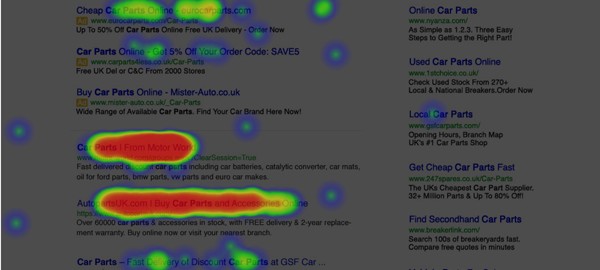The trouble with SEO and many SEO professionals is a pure fixation on rankings. Sounds crazy, but it is a problem. Forget the stuff that comes from really poor search marketing. Shady link building, an unhealthy obsession with the glamour keywords (i.e. the big keywords with big search volumes). The problem is the majority are fixated with doing half a job.
Have a think back, all of the articles you’ve read covering SEO. How many articles, as a percentage, focus on how you get your site to rank high for certain keywords? Pretty big percentage. How many articles focus on how you get users to click on your ranked listing? Very few. How many discuss what happens once the user clicks on the listing? Very few again.
I conducted a study a few months ago looking at how users engage with a search engine results page (SERP) and the reasons behind their selections. 200 UK respondents were shown the SERP shown below and told:
“You are looking to find an ecommerce site that sells car parts. You go to Google and search for car parts. You see the following results page, which website would you click on first?”
The heat click map is shown below and the data is available here.

38% percent said that they clicked the first result because they always click the first ‘non-ad’ result. Good for the first result! That leaves 62% of searchers that didn’t make their click based on the ranking position.
Meta description click through rate
Take a look at the webpage listed at number four in the organics; Parkers. In the UK, car parts is a keyword that receives an average of 40,500 searches per month. Now, if your business sells car parts, and your SEO employee, consultant or agency gets your site ranked at number four for that keyword, on the face of it you’d probably be delighted. But of the 200 respondents, look at how few selected Parkers. I don’t have the exact numbers on how many of our respondents selected Parkers, but it’s likely to be single figures. Lets hypothesise that it was five respondents, 2.5% of searchers clicking Parkers. For a term searched for 40,500 times per month, that’s 1,013 visits. Not too bad. But, what if you could increase the click through rate (CTR) by 1% to 3.5% of searches. That would bring in an additional 405 visits per month, 4,860 visits per year.
So, where does the SEOs job end? Is it a job well done when you get a website ranking on the first page of Google for a desirable keyword? Absolutely not, it’s a job half done. Unfortunately, when an SEO gets a site ranking for a keyword like ‘car parts’, they tend to sit back and bask in their greatness and client admiration, rather than moving onto the next task of ensuring that, now the website is in the shop window, users actually visit the website.
This is where there’s a blur between roles and responsibilities with conversion rate optimisation. The meta description is undoubtedly an area that falls under the SEOs’ remit. All too often, the meta description is a last minute, hacked together piece of meaningless waffle. There’s a simple reason for this. SEOs are responsible for meta descriptions, but because meta descriptions do not contribute to Google ranking factors, SEOs put little time and attention into them. Madness! You throw a load of money and time at getting a website to rank for valuable keywords, to get the website in the shop window. Then, when you do get the message in the shop window, you spend practically no time or attention on crafting the message.
How do users make their selection?
Sticking with the Parker’s example, have a look at their meta description here:
“Welcome to Parkers the parts people and our online workshop for all car parts and accessories. The parts people are one of the UK’s leading distributors of…”
Never mind spending little time on a meta description, they’ve spent no time on a meta description! Google have drawn that from the first line on the website because Parkers haven’t created a meta description. Their website is presented in front of 40,500 potential customers each month, and they’ve left whether these customers visit their site down to chance.
So, we’re clear, SEO doesn’t stop when your site is ranking on page one for a valuable keyword. But, what are users looking for in a meta description? How do we improve the click through rate. Here’s some (not all) of the reasons that our respondents gave for their car parts SERP selection:
- UK Based – 11%
- Product range mentioned – 7.5%
- Discounts mentioned – 7%
- Brand recognition – 5%
- Free delivery mentioned – 5%
- Looks trustworthy – 5%
- Clarity of offer – 4.5%
- UK domain – 4.5%
- Fast delivery mentioned – 1.5%
- Local offline locations mentioned – 1.5%
- UK mentioned in title – 1.5%
- Warranty mentioned – 1.5%
These reasons will differ slightly between industries and keywords, so the best way of identifying the key factors behind searcher click through rate for your products and search terms.
Testing click through rates for your SERPs
Setting up a CTR test for a SERP is a straightforward and low cost task. Here’s how you do it:
- Have a clear hypothesis written down. What are you testing? What element do you believe is the key factor in your industry for CTR? Maybe test it out against a couple of different alterations. Let’s say you think the mention of local depots is a big factor. What if two different listings have local depots? Throw in another differentiator between the two that you think may have an impact. Include local depots in a PPC listing, does that get more clicks than an organic result without mention of depots?
- Download an editable Google SERP psd. There are a few out there. This one is pretty good but needs a couple of tweaks to bring it inline with the current Google display.
- Next, play around with the .psd, change whatever you need to change with the listings and search. I’d ideally copy the current search results for the keyword you’re testing, then if you need to make little changes to test your hypothesis, do it.
- If you don’t already have one, create a survey monkey account and set-up a simple questionnaire. You can simply include the fictional SERP you created, explain the context of the situation to the user, ask them which selection they’d pick and why. Don’t ask any leading questions. Make sure the situation description is clear and precise, but in no way sways them towards a certain selection.
- Now you need to find participants. You can use existing customers, however the fact that they’re all aware of your brand and already buy from you is highly likely to skew the results. Better to use either Mechanical Turk or CrowdFlower. These are two crowdsourced marketplaces which allow you to pay individuals small amounts of money for small tasks. In our case, we can pay small amounts of money to each individual for completing our survey. I’ve not used Mechanical Turk as tasks can only be created by US residents and businesses. I have used CrowdFlower for surveys. Respondents will be directed to your SurveyMonkey questionnaire. Work with as many respondents as you think necessary to create a credible sample size.
Once the results are in and you’ve analysed them, you should have a much clearer picture of the factors behind the SERP selection for your market and you can implement the findings in your meta description copy.
Don’t leave your SEO job half done!
This post was originally published on liamcurley.co.uk
Digital & Social Articles on Business 2 Community(87)





